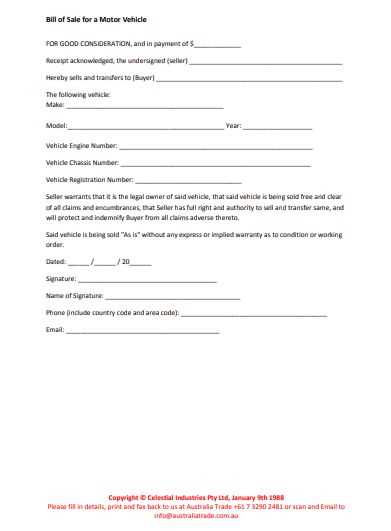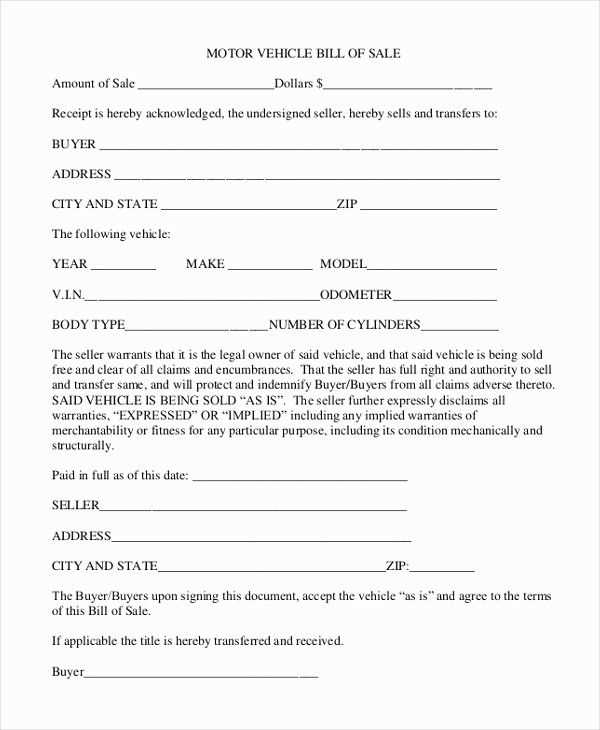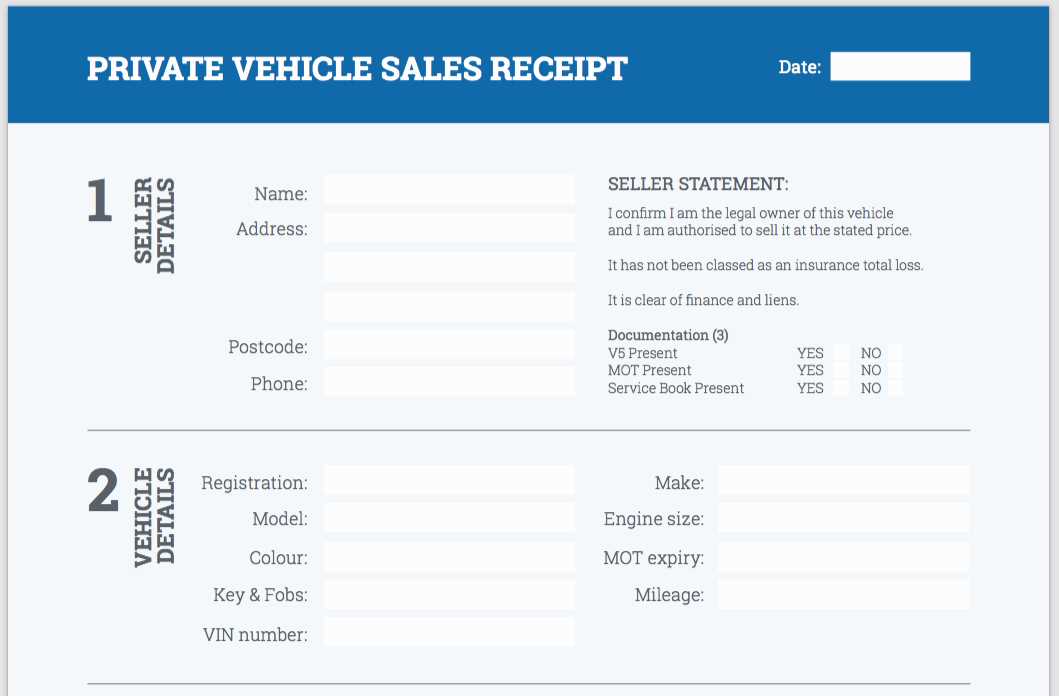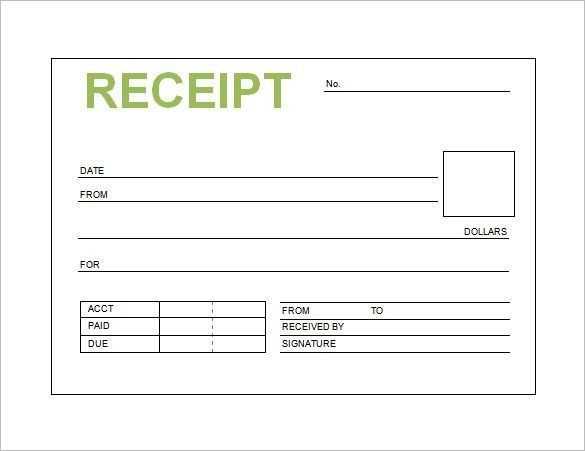
For a smooth transaction, it’s crucial to use a well-structured receipt when selling a vehicle. A receipt not only records the sale but also serves as proof for both parties involved. Begin by including the date of the transaction, which ensures clarity on the timing of the sale. Make sure to specify the buyer’s name and contact information, along with the seller’s details.
List the vehicle details, such as the make, model, year, VIN (Vehicle Identification Number), and mileage. This guarantees that the specific vehicle being sold is clearly identified. Including the sale price is crucial for both record-keeping and legal purposes.
Don’t forget to mention the payment method, whether it’s cash, bank transfer, or another form. Also, note any warranties or conditions of the sale, such as whether the vehicle is sold as-is. The receipt should be signed by both the buyer and seller to finalize the transaction and provide mutual acknowledgment.
Receipt of Vehicle Sale Template
For a smooth transaction, a well-structured vehicle sale receipt is necessary. It provides both parties with clear documentation of the sale. Below is a template that can be easily adapted to your specific needs:
Receipt of Vehicle Sale
Seller’s Information:
Name: [Seller’s Full Name]
Address: [Seller’s Address]
Phone Number: [Seller’s Phone Number]
Email Address: [Seller’s Email]
Buyer’s Information:
Name: [Buyer’s Full Name]
Address: [Buyer’s Address]
Phone Number: [Buyer’s Phone Number]
Email Address: [Buyer’s Email]
Vehicle Information:
Make: [Vehicle Make]
Model: [Vehicle Model]
Year: [Vehicle Year]
VIN (Vehicle Identification Number): [VIN Number]
Odometer Reading: [Mileage]
Color: [Vehicle Color]
Sale Information:
Sale Price: $[Amount]
Date of Sale: [Sale Date]
Payment Method: [Cash, Check, Bank Transfer, etc.]
Payment Status: [Paid in Full / Deposit Received]
Additional Terms:
[Include any additional terms, warranties, or agreements made during the sale]
Seller’s Signature: ___________________________
Date: [Date]
Buyer’s Signature: ___________________________
Date: [Date]
This receipt confirms the transfer of ownership of the vehicle listed above from the seller to the buyer. Both parties acknowledge and agree to the terms outlined above.
How to Include Buyer and Seller Information
Ensure both the buyer’s and seller’s information is clearly outlined on the receipt. This section is key for confirming the parties involved in the transaction.
Buyer Information
- Full Name: Include the buyer’s full legal name as it appears on their identification.
- Address: Provide the buyer’s residential address, including city, state, and ZIP code.
- Contact Information: Add the buyer’s phone number and email address for future communication.
- Driver’s License Number: List the buyer’s driver’s license number for verification, if applicable.
Seller Information
- Full Name: Use the seller’s full name as per legal documents.
- Address: Include the seller’s address, including city, state, and ZIP code.
- Contact Information: Provide the seller’s phone number and email address.
- Driver’s License Number: Seller’s driver’s license number may also be included for identification purposes.
Key Details to Specify About the Vehicle
Clearly list the make, model, and year of the vehicle. These details identify the car and avoid confusion with similar vehicles. Include the Vehicle Identification Number (VIN) for precise identification and verification.
Condition and Mileage

Indicate the vehicle’s current condition, including any damage or repairs. This gives the buyer a clear picture of its state. Be honest about the mileage, as this significantly impacts the vehicle’s value.
Ownership and Title Status
Specify whether the vehicle has a clear title, is financed, or has any liens. Provide the number of previous owners, as this can affect the buyer’s confidence in the vehicle’s history.
Structuring Payment and Transaction Terms
Clarify payment methods upfront to avoid confusion. Specify whether payments will be made via bank transfer, cheque, cash, or other means.
- Payment Schedule: Break down the payment schedule in clear terms. Indicate any deposits, installment amounts, or due dates.
- Late Payment Fees: Define penalties for delayed payments. State how much will be charged per day or month past the due date.
- Transaction Details: Include specifics on transaction processing fees, if applicable, and who is responsible for covering these costs.
Address the delivery method and its associated costs, if any. Be specific about timelines and who assumes the risk of loss or damage during transport.
- Transfer of Ownership: Specify the exact point at which ownership transfers. Commonly, this happens upon full payment or at the signing of the contract.
- Refund Policy: Outline the conditions under which a refund may be issued, along with the time frame for returns or cancellations.
Ensure that all terms are clearly stated, agreed upon, and understood by both parties before finalizing the transaction.
Documenting the Date and Location of Sale
Clearly specify the exact date and place of the vehicle transaction. These details solidify the agreement and are key in validating the sale. Ensure both parties agree on the date, and note the city and state where the sale took place.
Date of Sale

The date must reflect the day when ownership was transferred to the buyer. It is crucial for registration and tax purposes. Record the date in a clear format, for example, “February 5, 2025”. Both parties should verify and sign it on the same document.
Location of Sale
The location should include the city and state where the transaction was finalized. It helps with jurisdiction in case of disputes. Ensure the address is correct and specific, listing the exact location of the meeting or transaction.
| Detail | Example |
|---|---|
| Date of Sale | February 5, 2025 |
| Location of Sale | 123 Main St, Springfield, IL |
Additional Clauses for Warranty or “As-Is” Sale
Specify whether the vehicle is sold with a warranty or “as-is” condition. If a warranty is offered, outline its duration, what it covers, and any exclusions. Clearly state if repairs or replacements are covered, and note who is responsible for associated costs.
For an “as-is” sale, clearly indicate that the vehicle is sold without any guarantee or warranty, and that the buyer accepts the vehicle in its current condition. Include a clause confirming the buyer has inspected the vehicle and acknowledges any potential defects or issues.
If the vehicle is sold “as-is,” include a disclaimer about the seller’s liability. This limits any future claims related to defects or damages. Ensure both parties acknowledge and sign this clause to prevent misunderstandings.
Consider including an inspection clause, where the buyer agrees to have the vehicle inspected by a professional before the sale is finalized. This adds transparency and helps mitigate future disputes.
If applicable, include a clause stating the buyer understands that certain vehicle defects may not be immediately visible and are not covered under warranty in “as-is” sales.
Formatting and Signing Requirements for Validity

Ensure the document is clear and structured, with distinct sections for the buyer’s and seller’s details, vehicle information, and transaction terms. The buyer’s and seller’s names, addresses, and signatures must be provided, alongside the vehicle’s make, model, year, and VIN (Vehicle Identification Number). These details are vital for verification purposes.
Both parties should sign and date the document in the presence of a witness or notary, if required by your local laws. The signatures confirm agreement to the terms and transfer of ownership. If applicable, ensure the document is notarized to meet legal requirements.
Use a legible, formal font, and avoid handwritten elements unless absolutely necessary. The document should be printed on standard letter-size paper for ease of processing. Double-check that all fields are completed correctly before signing to prevent disputes.


